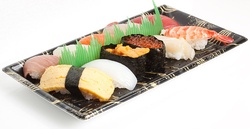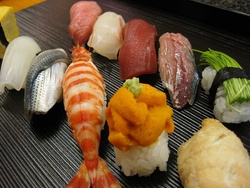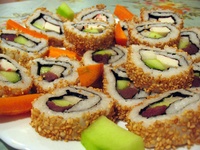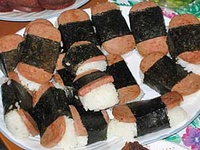Sushi and I made our acquaintance nearly sixty years ago on a train ride from Iwanuma to Sendai. In those days, the government wasn’t as particular as now about “sanitation,” and food vendors were allowed to course the railroad cars offering their wares without anyone batting an eye. As we left Iwanuma, a soft call filled the car:
“Sun-bun, suzubentooo…Ocha…ochaaa….” A food vendor was promoting her wares. Muffled giggles followed her call.
“Hi, banchan,” a customer called and, with a smirk on his face, he added, “suzu-ben!” Because of the traditional Japanese politeness that typically infused every mercantile transaction, the customer’s attitude left a deep impression on me. I recounted the incident to one of my friends.
“Don’t fret,” he said. “It must have been a Kanto snob, trying to be cute. Sunbun is Tohoku-ese for shinbun (newspaper) and suzu-ben is sushi bento…and you know what that is.”
I was less interested in the bento meal than I was in the wooden tray that held it. After eating the meal, you would just throw in the garbage that fragile, beautifully handcrafted box. How I wish I had saved one of those delicate pieces as an example of Japanese creativity.
I know sushi is a universal delicacy favored by millions of aficionados but, being an unredeemed namban, southern barbarian, it took me a few months to get familiar with it, a few more years to like it, and up to now to find how it came about.
None of our current versions are what sushi originally was. Chinese records of the Second Century AD list a food made of pickled fish and fermented rice (鮓). And by the Third Century BC, the Chinese had a chow made with pickled fish (鮨) and another made with meat and pork (identified with the character 醢), though neither product was associated with rice. These delicacies remained on Chinese menus until the Ming Dynasty (1368-1664), when they suddenly vanished.
In Japan, an old law document, Yororitsuryo, or Taiho Ritsuryo,1 is the first to mention “sushi.”2 Found there is a reference to an in-kind tax paid with “zakonosushi” or “zatsunosushi,” a term which the Orientalists haven’t yet fully defined, or even learnt how to pronounce. That sushi was salted fish pickled for a year in rice. It reeked of blue cheese, nato, pungent kimchi, and animal glue combined, heftier than today’s narezushi(fermented sushi). Would you blame the fussy people of those days for eating the fish and dumping the rice? Why then, you might ask, would revenuers enforce its collection in over 20 provinces? Simple: from the Emperor down, every courtier drooled at its mere sight!
With the introduction of rice vinegar, things rapidly changed. By the Muromachi era (1316-1573), sushi makers began relying more on vinegar than on fermentation. The pickled fish’s flavor was still popular, but not its aroma.
In the early 1700s, someone in Osaka developed oshizushi, which required little fermentation; eventually, the style migrated to Edo. When nigiri made its debut, sushi became one of Japan’s favorite fast foods, and a cooking specialty with a variety of styles. Still, the fish needed to be cooked or pickled.
Then, with the advent of refrigeration, “Edomae” sushi,3 what we recognize as sushi today, became the top public infatuation. Currently, almost every region or province in Japan has its own particular styles and fashionable sushi hangouts.
As a fast food, sushi in Japan runs circles around the hamburger in America. To further speed its delivery, Yoshiaki Shiraishi of Osaka developed the kaitenzushi—conveyor belt sushi.
Next, Kura, a kaitzensushi chain, and the giant videogame maker Sega, teamed to create a faster way of ordering and delivering it. On a liquid crystal computer screen displaying a virtual aquarium, a customer selects exactly what he wants to eat. The order goes to a monitor in the kitchen; a conveyor belt promptly delivers the sushi to the customer; and all the records are precisely entered in the memory of the machine. No waste, no accounting errors.
Essential to the preparation of modern sushi is properly cooked rice. And sushi connoisseurs swear that, despite the advent of the rice-cooker, only the Japanese know how to cook rice to perfection. It has to be adequately measured, washed a number of times, set in water to rest and expand, and finally cooked systematically: first until the water boils, and then simmered until fluffy.
The old recipe said to use enough water to reach your wrist while the palm of your hand presses on the amount of washed and soaked rice you need to cook. You can read the recipe as many times as you want, follow the ratio of cups of water to cups of rice, and try all imaginable gimmicks, but only practice and experience will let you produce perfect gohan—or shari,4 as sushi chefs call it.
Of course, you could start when you’re just old enough to be allowed inside the daidokoro, the kitchen of an old Japanese rural home. First, you’d get the crystalline water from the well or the pump. Then, you would learn to cook the grain in the ancient o-kama, a giant steel pot (later aluminum) topped with a heavy wooden cover.
Next, you’d set the contraption inside the kamado (fire range for wood or charcoal), blow your innards out through a bamboo pipe to control the fire, and lastly pray to Koujin or Kamado-no-Kami, the Fire God, for success. The process may help you become an athlete. But then, you might prefer just a great, electronic rice-cooker, whose manufacturers’ instructions you can follow precisely!
As for the Japanese, only the rice grown in Japan (Oryza sativa japonica) has the flavor, the texture and the satisfaction expected for sushi rice. (I don’t know how the proud Californian Nikkei growers would feel about that.)
The varieties of sushi are already numerous, and so are the styles of the shops who serve it. There’s Inari sushi, our famous “footballs” without which no Japanese picnic would be a total success and no decent fox would intercede for a good crop. There are also temari, temaki, maze and makizushi, nigiri, tekka, kappa, hoso, futo, natto, uramaki, and gunkanmaki. And, of course, that formidable belly-pleaser at which my wife excels: chirashi.
Because ginger is considered a good germicide, it often accompanies raw-fish sushi. California and Hawaii have added the “California roll” and the “Spam musubi,” respectively, but purists consider such newcomers gross hybridization.
In some sushi places you’ll find a menu listing prices; there, you can go as far as your budget will allow. In other places there is no menu, and the steady clientele may be willing to accept the chef’s whims. You might end there with a double surprise: one, the fare; and two, the fee.
There is much more to learn both about sushi and its products. Begin with the enormously interesting paper by Cindy-Hsim I-Feng, Beyond Nigiri and Anisakiasis, which I thoroughly enjoyed. Also, visit the history pages of japanguide.com and similar links on the topic. You’ll have a ball. Next time, I’ll try my hand at exploring the history of sushi in Los Angeles.
Notes:
1. Liu, David J. JAPAN – A Documentary History. 1997. New York. M.E. Sharpe; pp. 29-30
2. Wikeppdia– the Free Encyclopedia. “History of Sushi.”
3. So called because the fish was caught in Edomae, the waters off the shores of Edo (Tokyo), between current Tsukiji and Teppozu, an area now highly polluted. Kateigaho Intl. Edition; Spring 2003- Inaugural issue.
4. Shari originally meant “bones of the Buddha”— perhaps because rice once was just as valuable. The East Magazine; Vol. XXVII, No. 5
*This story first appeared in the East San Gabriel Valley’s Japanese Community Center’s “Newsette” in December 2008.
© 2008 Edward Moreno











